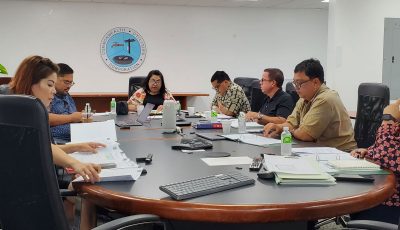EPA: CUC holds ‘groundbreaking’ rites for pipeline in 2011 but no ground was broken
The Commonwealth Utilities Corp. held a “groundbreaking ceremony” in 2011 for the construction of a fuel pipeline in Lower Base, but no ground was broken and the pipeline has not been constructed, according to the U.S. Environmental Protection Agency.
In CUC’s response, CUC petroleum and compliance manager Andrew Longworth stated that CUC has pushed this pipeline project from the start.
Missed deadlines were due to the poor performances of approved contractors, said Longworth in a declaration on Monday in support of CUC’s reply to EPA’s report.
EPA, through U.S. Department of Justice Environmental Enforcement Section senior attorney Bradley R. O’Brien, disclosed that U.S. District Court for the NMI designated judge David O. Carter spent an extensive time discussing the CUC pipeline and CUC’s inability to replace the approximately one mile above-ground pipeline that delivers fuel to Power Plants 1 and 2 in Lower Base from the Mobil oil bulk storage facility.
“The new pipeline construction is critical as the CUC pipeline is poorly maintained and degraded, leaks, and is no longer safe to operate at pressure,” said O’Brien in EPA’s July report filed in federal court on Friday.
Notwithstanding the pipeline risks, O’Brien said CUC violated numerous court deadlines for constructing this critical oil transport conduit.
The pipeline project was initiated in 2010 at a cost of $1.8 million. Due to numerous problems that contributed to the project’s delay, the cost ballooned to $6 million this year.
CUC was initially required to complete the pipeline by Feb. 24, 2011.
O’Brien said the court subsequently gave CUC multiple extensions of time—2011, 2012, 2013, and 2014—to complete the pipeline.
O’Brien said the reasons for CUC’s unexcused failure to timely build the pipeline include, in part, that the U.S. Department of Transportation Pipeline and Hazardous Materials Safety Agency determined that the initial pipeline design did not comply with regulations and that CUC’s first construction manager resigned in 2011.
The other reasons are that CUC did not make an earnest effort to hire a new construction manager until ordered by the court; failure to timely order needed equipment; contract and procurement delays; inability to submit an adequate construction execution plan; failure to provide adequate information regarding subcontractors; and failure to draft basic design and construction documents.
O’Brien said that important approvable construction documents were only recently submitted to EPA, such as the construction execution plan and quality assurance plan.
Further, the lawyer said, it was not until June 10, 2014, that CUC informed EPA that CUC had not ordered the pipe bends (curved piping) necessary for the pipeline construction.
In CUC’s response to EPA’s July 29, 2014, report, CUC petroleum and compliance manager Longworth pointed out that the extensions were requested by the utility on the advice of Vanderpool Pipeline Engineers, the construction manager.
Longworth said delays were outside of the utility’s control, despite the utility’s constant follow up.
Regarding the bends, Longworth said CUC informed EPA of this potential issue on numerous occasions, beginning in November 2013.
He said a purchase orders for the bends was issued by Smithbridge on May 10, 2014, to Houston Pipe benders, in Texas.
Longworth explained, among other things, that the multi-stage inspections were done by construction manager Vanderpool, during the fabrication, coating and quality inspection.



























